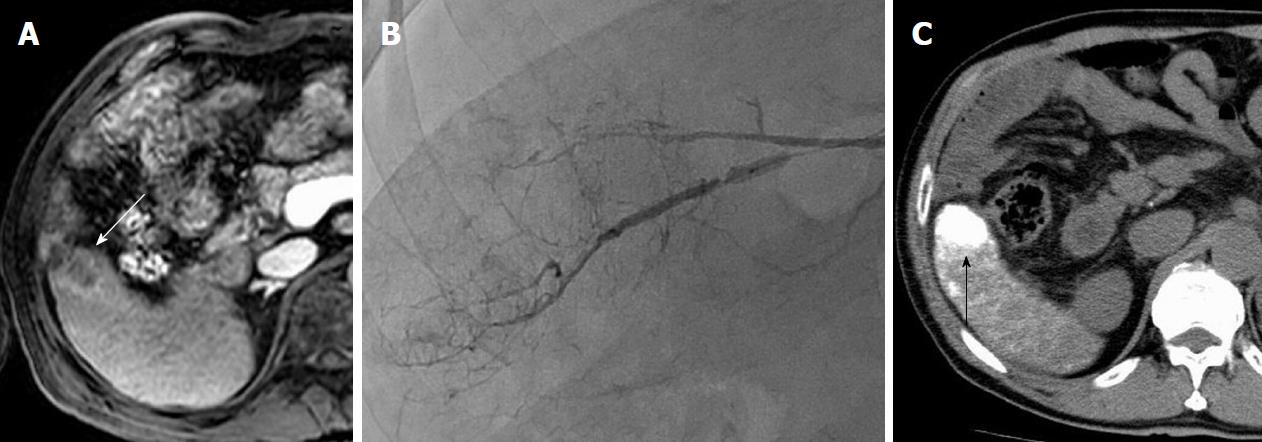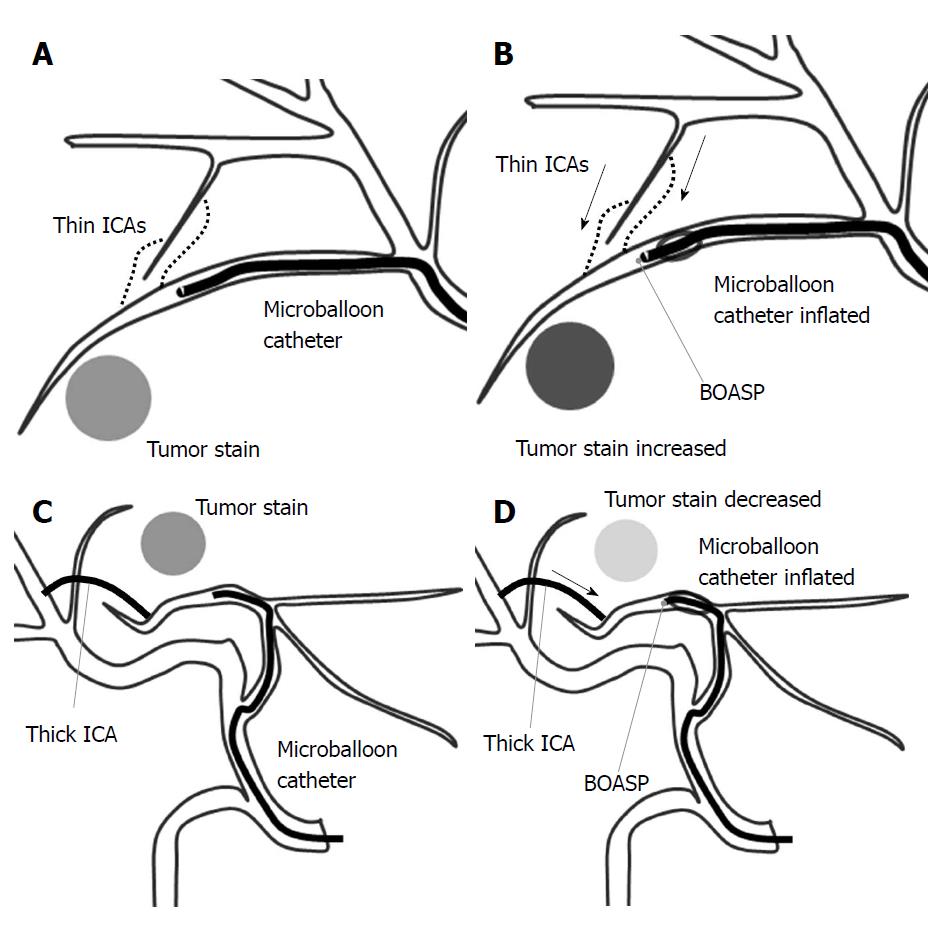Copyright
©The Author(s) 2018.
World J Hepatol. Jul 27, 2018; 10(7): 485-495
Published online Jul 27, 2018. doi: 10.4254/wjh.v10.i7.485
Published online Jul 27, 2018. doi: 10.4254/wjh.v10.i7.485
Figure 1 A 71-year-old female patient with hepatitis-C related hepatocellular carcinoma 45 mm in diameter underwent balloon-occluded transcatheter arterial chemoembolization.
A: A 3-Fr microballoon catheter was inserted into a tumor-feeding artery. After achieving occlusion with the microballoon catheter (yellow arrowhead), emulsion of lipiodol and miriplatin was infused until the cancer nodule (white arrowhead) was sufficiently filled. Fragmented gelatin sponge slurry was then injected; B: Just after B-TACE, computed tomography (CT) showed a dense lipiodol emulsion (LE) accumulation in HCC nodules (red arrowhead); C: Four years after B-TACE, CT showed that the volume of the LE accumulation was reduced (black arrowhead) with no local recurrence. HCC: Hepatocellular carcinoma; B-TACE: Balloon-occluded transcatheter arterial chemoembolization.
Figure 2 A 75-year-old man with hepatitis-B related hepatocellular carcinoma.
A: Gadolinium-ethoxybenzyl-diethylenetriamine pentaacetic acid-enhanced magnetic resonance imaging (EOB-MRI) showed that HCC was slightly enhanced in the arterial phase (white arrowhead); B: While angiography did not show the tumor stain obviously, we injected the lipiodol emulsion (LE) and fragmented gelatin sponge slurry from tumor-feeding artery under occlusion with microballoon inflation; C: A favorable LE accumulation (black arrowhead) was seen on computed tomography one day after balloon-occluded transcatheter arterial chemoembolization. HCC: Hepatocellular carcinoma.
Figure 3 A 74-year-old woman with hepatitis-C related multiple hepatocellular carcinoma.
A: Contrast-enhanced computed tomography (CT) showed that multiple HCC nodules were observed, aggregated at segment 8 (white arrowhead); B: Computed tomography showed that the dense lipiodol emulsion (LE) accumulations (red arrowhead) were observed just after balloon-occluded transcatheter arterial chemoembolization (B-TACE) for multiple HCC; C: We carried out additional B-TACE because local recurrence was detected on follow-up CT. Favorable LE accumulations were observed just after additional B-TACE (yellow arrowhead); D: Three month after additional B-TACE, local recurrence was not observed, and the LE accumulations were shrinking (black arrowhead). HCC: Hepatocellular carcinoma.
Figure 4 A schematic illustration of the balloon-occluded transcatheter arterial chemoembolization procedure.
A: A microballoon catheter is inserted into the tumor-feeding artery and inflated to occlude it. If the distal arterial blood flow cannot be stopped, the intrahepatic collateral arteries (ICAs) may be maintaining the distal arterial blood flow; B: When the ICAs are thin, the balloon-occluded arterial stump pressure (BOASP) is remarkably reduced compared to the arterial pressure without balloon occlusion. In this situation, we might observe increased tumor enhancement on selective computed tomography during hepatic angiography (CTHA) after balloon occlusion. A remarkable reduction in the BOASP is thought to allow us to inject the lipiodol emulsion (LE) under higher pressure, leading to the denser LE accumulation in targeted tumors. The BOASP after the injection of LE and gelatin particles is significantly higher than that before treatment; C and D: When the ICAs are thick, the BOASP is expected to be mildly reduced or unchanged because of the adequate blood flow from a thick ICA. In this situation, we might observe decreased tumor enhancement on CTHA after balloon occlusion. We would probably inject the LE under lower pressure in such a situation, thereby achieving a less-dense LE accumulation.
- Citation: Hatanaka T, Arai H, Kakizaki S. Balloon-occluded transcatheter arterial chemoembolization for hepatocellular carcinoma. World J Hepatol 2018; 10(7): 485-495
- URL: https://www.wjgnet.com/1948-5182/full/v10/i7/485.htm
- DOI: https://dx.doi.org/10.4254/wjh.v10.i7.485
















